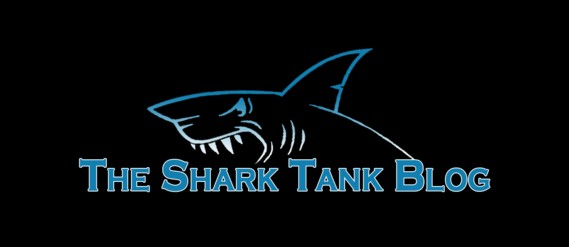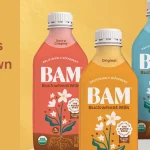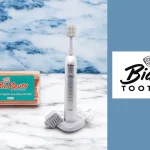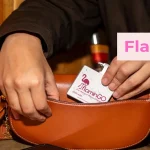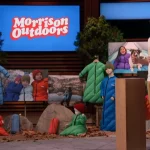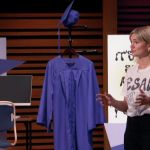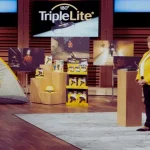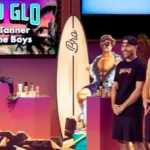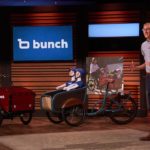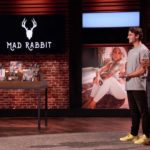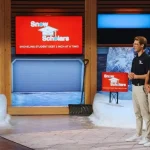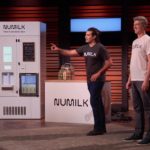Beyond the Tank Episode 107
 Beyond the Tank episode 107 aired January 21, 2016. It is the fourth episode of the “second season” of the hit show. Three past Shark Tank companies get an in-depth, 20 minute update segment on what their life is like after Shark Tank and viewers get to see them interacting with their investor/sharks. Beyond the Tank episode 107 features a look at Barbara Corcoran’s continued success with Cousins Maine Lobster, the lobster vending truck turned lobster wholesaler, from season 4. We also get a look at Moziah Bridges, who didn’t get a deal in season five, but received mentoring from Daymond John. Finally, Mr. Wonderful visits with the folks at Bottle Breacher, a company both he and Mark Cuban invested in during season six.
Beyond the Tank episode 107 aired January 21, 2016. It is the fourth episode of the “second season” of the hit show. Three past Shark Tank companies get an in-depth, 20 minute update segment on what their life is like after Shark Tank and viewers get to see them interacting with their investor/sharks. Beyond the Tank episode 107 features a look at Barbara Corcoran’s continued success with Cousins Maine Lobster, the lobster vending truck turned lobster wholesaler, from season 4. We also get a look at Moziah Bridges, who didn’t get a deal in season five, but received mentoring from Daymond John. Finally, Mr. Wonderful visits with the folks at Bottle Breacher, a company both he and Mark Cuban invested in during season six.
Each Episode of Beyond the Tank has these “back stories” and Shark Tank updates. We’ll recap them here.
Beyond the Tank Episode 107 Featured Sharks
- Investor – Kevin O’Leary
- Investor – Barbara Corcoran
- Investor – Daymond John
Beyond the Tank Episode 107 Featured Entrepreneurs
- Company – Bottle Breacher
- Company – Cousins Maine Lobster
- Company – Mo’s Bows
Beyond the Tank Episode 107 Recap
Cousins Maine Lobster
Sabin and Jim came to the Shark Tank in season 4. They landed a seafood deal with Barbara Corcoran for $55,000 in return for 15% of their company. Barbara is excited to be swimming with the entrepreneurial cousins.
“Jim and Sabin are two of the best entrepreneurs I’ve ever met on Shark Tank. They’re equally strong in their respective roles. They’re perfect entrepreneurs.”
The cousins have brought their Maine roots, and their love of lobster and seafood to LA and beyond with Barbara’s help. When they appeared on Shark Tank, they had a single food truck. Now they have four trucks in Los Angeles, and 10 franchises across the country. In three years, they’ve done over $7 million in sales, a phenomenal number for a specialty business.
The pair don’t just do lobster. They’ve partnered with Big Brothers and Big Sisters of LA, in conjunction with their own charity, Cousins For a Cause, in order to reach out to the community and make a difference. Sabin’s Little Brother, Lawrence, has benefitted from the cousins’ dedication.
“It’s changed me, a lot. Just being with somebody who cares, to call him my brother, it means a lot,” says Lawrence.
Now that the cousins have been able to impact the neighborhood, they feel ready to move to the next stage of their business and open a small restaurant in LA. The problem is, they’ve done it once already, and failed. Their first attempt shared space with another business, and the pair feels the venue and timing just weren’t right.
“It ended up being a disappointment,” says Jim. “We rushed into that opportunity. It not being successful left a sour taste in my mouth, because I really believe in it. We never really gave up our idea and our passion to open up a restaurant.”
Barbara is not enthusiastic about the idea of making a second attempt.
“They are making a ton of money and they’re doing well, but I know they’re going in nine directions at once. They want to open another restaurant, and I’m not crazy about it.”
The pair has already invested $250,000 into their restaurant idea, and have signed a lease for 5 years. They’re partially committed, but they need Barbara’s guidance to get a solid start.
She’s impressed with their progress so far. “I thought it would take you 10 years to reach ten million,” she says.
The pair present the idea to her, but Barbara is concerned about the high rent in the prime location they’ve chosen. “The restaurant industry has a poor report card,” she tells them, “With 70% failing within the year.”
Sabin argues that they have 14 restaurants, but they’re on wheels. Barbara points out that they roll where the demand is, following their markets. Jim responds that the neighborhood they’re intending to enter with their restaurant is closed to food trucks, as an upscale neighborhood, and that the open hours will be later in the afternoon and evening – hours that the trucks simply don’t operate.
Barbara is reluctantly convinced by their logic. “You guys seem to succeed at everything you put your feet on, and you’ve got the energy, so ok, I’m sold,” she says.
The pair meet her capitulation with cheers.
Barbara has been convinced by the energy and determination the pair have shown so far. “They’re going to succeed,” she says, “Because they have to succeed. They have the kind of drive and ego that just doesn’t accept failure.”
Jim and Sabin want to show her their design ideas, and get her input as an expert.
“What do you think about the color?” asks Sabin.
Barbara contemplates. “Don’t ask me about the color unless you want the truth,” she warns them. The pair assure her they do.
“I hate it,” she says. “Don’t like it at all.”
The dismay is clear, but Barbara has suggestions for how the pair can improve their design, use bolder colors to capture their dream of a Maine-themed storefront, and create a space that will grab attention and bring in essential foot traffic.
“The plan sucked. Everything was wrong about it. I have to straighten them out on what they have to do to draw traffic in and make that a landmark.”
She gives them specific suggestions for color, design, and layout. The pair get to work, carefully choosing not only the materials for the outside of their restaurant based on Barbara’s suggestions, but the cutlery and equipment as well.
Barbara has her doubts, but is still confident in the pair’s abilities. “Jim and Sabin always want to jump on the next horse,” she explains, “and see how fast they can ride. I feel like I made them realize that they have a lot of work to do, and they’d better do it carefully.”
Jim knows this is their last chance. “If this restaurant fails, that’s it for us. We’re done with restaurants. There is no third opportunity here, and knowing that just adds to the intensity, adds to the pressure and the stress.”
Two months after Barbara’s visit, the pair is ready to open their new place. There is an energy of excitement and fun as the line of people moves into the restaurant. The food starts flowing out of the kitchen, and the customers are clearly impressed. The opening is a success, and Cousins’ Maine Lobster is on its way.
Their Shark is pleased and proud of their progress. “Jim and Sabin are walking, talking examples of entrepreneurship at its best. They’ve done amazingly well with their franchise business, and now they’re in the restaurant business. And it’s the talk of the town! Can’t wait to see what they do next.”
Mo’s Bows
Mo Bridges came to Season 5 of Shark Tank, when he was 11 years old. During his presentation, Daymond John tells him that, “In 1989, I was offered $10,000 for 40% of my company. Ten years later, that would’ve been worth, to somebody else, $40 million. I’m glad I didn’t take that money. I strongly suggest that you do not take on investors at this time.”
Daymond offered to mentor Mo, and with his advice, Mo turned down an offer from Kevin O’Leary.
Now Mo’s Bows are sold in Neiman Marcus, and in several specialty shops in the South. Mo’s mother, Tramicia, helps run the company, but the thirteen year old entrepreneur is in charge of design and makes most of the decisions. They’ve had to plan their marketing and sales campaigns around his school and other activities.
“Working with a teenage entrepreneur is a little challenging,” admits Tramicia.
“Some people think that, since I am 13, and I am younger, that my mom’s doing the work. Well let me tell you right now, that is not true. I pick out the fabric. I write hand-written notes to my customers, and I just really have a passion for my business,” responds Mo. It’s clear that this young man is excited about his business.
The pair are heading to NY to visit Daymond. Mo’s excited. He wants to talk to Daymond about expanding the line. “I do want to have a whole men’s line,” he explains, “And I want to add women’s clothes, too.”
Mom’s not sure this is the right time to begin adding new lines. “Mo wants to expand, Mom thinks he should wait, so I’m really looking forward to getting Daymond’s input on that,” she says.
Daymond is looking forward to the meeting. “I chose to mentor Mo because fashion is my passion. I understand the single-mom/kid relationship. I’m clearly the smartest Shark, and I only want the best for him.”
Daymond sits down with the pair and asks Mo about his business, about how its’ going so far. Mo explains that Neiman Marcus sales have been strong, and now he wants to expand his line to include a wider range of products.
Daymond explains that in business, it’s “twenty times easier to upsell a customer that you have than to acquire a new customer.”
Mo has already started to widen his offerings to neckties. Daymond tells him that expanding into neckties is a solid move, but that he should continue to build the Mo’s Bows line before expanding into new clothing lines. “You have to concentrate on this and be the king of this,” says Daymond.
He also talks to Mo about his relationship with his Mom. Mo, as a teenager, is beginning to feel smothered by his mother. “I think Mom is too clingy,” he says. “She gets all up on me.”
Daymond chuckles. “I hate it when they get all clingy,” he says, but goes on. “I want to let you in on a little secret. As a parent, it’s not fun always having to wipe your butt and make your food when we’re tired, so don’t think it’s a one-way street.”
He steers the conversation to the numbers, asking Mo about his gross sales. Mo responds that they’ve reached $55,000 in sales thus far this year. Last year, they reached $180,000.
Daymond pushes Mo to know the numbers in relationship to his business. “Mo is very passionate about his business from the design standpoint, but if he doesn’t understand his numbers, he may end up running a business that runs a negative.”
Daymond’s mentoring, though, goes beyond the simple business. He wants to take Mo on a tour of his neighborhood and show him his humble roots.
“I want to show him where I started, and where I began,” says Daymond. “Mo only thinks about me in fancy cars and big corporate offices, and he probably does not realize that I was just like him.”
Daymond explains to Mo that his house was his first factory. “There’s so much about Mo that reminds me of myself. When I was that age, fashion was all I could think about. I was a single child, so Mom and I were best of friends and partners. I was also a little lost, of course. At 13 years old, you have all these aspirations, but you don’t know how to get there.”
He shows Mo the house he grew up in, explaining that he and his friends used to breakdance on the sidewalk, hoping to be discovered by Run DMC.
“It’s really your roots,” he tells him, “that are going to keep you grounded. If you forget where you came from, then you’re really not going to have much direction in where you want to go.”
Mo is impressed. “It was very cool to share the memories that Daymond had when he was younger. The house was rich with history.”
Daymond brings Mo to Queens to show him the site of a Boyz to Men music video shooting. He explains how LL Cool Jay wore one of his Fubu sweatshirts in the video, giving him the national exposure that launched the company to the next level. He explains the importance of networking to Mo, telling him that LL lived in the neighborhood and Daymond had an opportunity to ask him personally to wear his clothes. “He stopped, and he said to me, ‘I’m not gonna forget my roots, and I will remember you, and I’m gonna take care of you.”
For the first time, Mo is seeing the power of the early networking opportunities he’s been offered. He’s a bright young man, and Daymond is giving him a lot to think about. The final place Daymond wants to show Mo is a place where he and some friends got pulled over. His friend had a gun, and they were all arrested.
“I remember those cold handcuffs being put on me. And they had to call my mother. My mother came up to the precinct, and she saw me locked up, and I saw the look in her eyes, the tears that came to her eyes, and it was the worst feeling I ever had in my life. She didn’t yell at me. She was just disappointed. I decided at that moment in my life, that I was never, ever going to hurt the one I loved like that. That’s the beautiful thing about a son and a mother and the bond that they have, and that’s why you have to do the best that you can do for her, because she’s doing the best that she can do for you. She’s been doing that for you since the day you were born. She gave you your life.”
Mo comes away changed. “Daymond has guided me to think about how I should not make bad choices. If the world is going to change, then it’s up to me to do it.
What’s next for Mo’s Bows is, I want to have a big impact, and I want to be known in the fashion world. It’s sometimes difficult for my Mom and I to work together, but I love my mom. She has motivated and inspired me to do what I love best. Without her, there would be no Mo’s Bows.”
Bottle Breacher
Former US Navy Seal Eli Crane and his wife Jen came to the Shark Tank in season 6. Jen had decided, during Eli’s second deployment, that she needed to keep busy. When Eli retired from the military to spend more time with his family, the pair decided that landing a Shark would be the best way to move their young company to the next level. Their appearance on Shark Tank was successful and they got a deal from Kevin O’Leary and Mark Cuban. Kevin’s main concern was the logistics – if they had a lot of orders, would Eli and Jen be able to deliver their customized bottle openers to their customers?
Kevin made the deal, for once, thinking with his heart rather than his checkbook. “Some people think of [the .50 caliber bullet casings Bottle Breachers are made from] as an instrument of death. I think of them as bullets for freedom. It just hit me, and became an emotional connection with the product.”
Describing his response to Eli’s story, Kevin tears up in an uncharacteristic display of emotion. “It’s very hard to think about it, as a father,” he says. “Even though I know I shouldn’t let emotions get in my investments, this one was different. I’m going to make damn sure they’re successful.”
Even the irrepressible Barbara Corcoran was impressed with the deal. “The truth comes out – @kevinolearytv has more heart than hair. He’s not afraid to put his heart into his partners. #beyondthetank” she tweeted during the Beyond the Tank airing.
With the deal in hand, Jen and Eli go home to start building their company to the next stage. They’ve already had solid successes. When they first came to the Shark Tank, they had made a solid $500,000 in sales. Since their appearance, sales have risen to $3.5 million.
“I was really thrilled with the response that we got right after we aired,” says Eli. “But it was bittersweet, because we have this huge backorder.”
Currently, the company has 8,000 units ordered. They are capable of producing 600 Bottle Breachers a day. The engraving alone takes 2.5 minutes. They are able to produce about 20 per hour with one person running one machine.
Kevin is coming to visit the couple and talk about their progress and what needs to happen next. Kevin is bringing along Alex Kenjeev, who runs O’Leary Ventures. He was the one who did the due diligence, and Kevin hopes he’ll have solid advice for the future of Bottle Breacher.
Kevin sums up the situation. “Bottle Breacher’s not shipping product fast enough. This is catastrophic. Basically, very pissed-off customers put their orders in over 8 weeks ago, still don’t have products. That’s one of the reasons that I’m here. I’ve got to fix this.”
Kevin explains to the couple that the customer service aspect of the business is critical to success. Eli admits that, to clear the backorder, they need to do 1,500 to 2,000 Bottle Breachers a day. Currently, they’re able to produce an average of 600.
Alex points out that they have a far greater capacity than they’re currently utilizing. Eli explains the process. The engraver has to enter the text to be engraved, and adjust it manually, for each Bottle Breacher, a process that takes time.
“Businesses fail for a lot of reasons,” says Kevin. “But when you fail for success, that’s a crime against humanity. That’s really what’s happening here. We are so successful in getting people to want our product, we can’t ship it to them!”
Kevin minces no words with the couple. “Nothing pisses a customer off more than ordering a product, then waiting until they’re dead of old age to get it. You’ve got to fix it,” he says.
Alex wants to talk about the potential of the current set up. Eli explains that the engravers could do close to 100 Bottle Breachers an hour, if they could bypass the manual data entry.
Alex recommends having the data entry work done ahead of time, and sending the pieces for engraving en masse.
With the problems addressed, the partners move on to the new products. Kevin is impressed with the wine opener, high-end wooden coasters branded with the Bottle Breacher logo, and the BBQ set with opener handles. He warns against expanding too quickly, but feels that the products they’re showing him are solid extensions of the existing brand.
“There’s a lot of people who want you to succeed,” Kevin tells the pair. “There’s a lot of potential here. There are also a lot of problems.”
After the meeting, Jen and Eli discuss ways to maximize the potential of the current engraving equipment. They go to a local company, that helps them design holders to allow the engravers to do multiple orders at once. Within a month, the back order is caught up. The time has been cut down from taking 2.5 minutes for each piece, closer to 20 seconds each.
Kevin is impressed. “In any business, you’ve got to take the good with the bad, and you’ve got to be able to pivot. I’m glad we went through these tough patches, and solved our problems together. These are special Americans, and this is a special company.”

